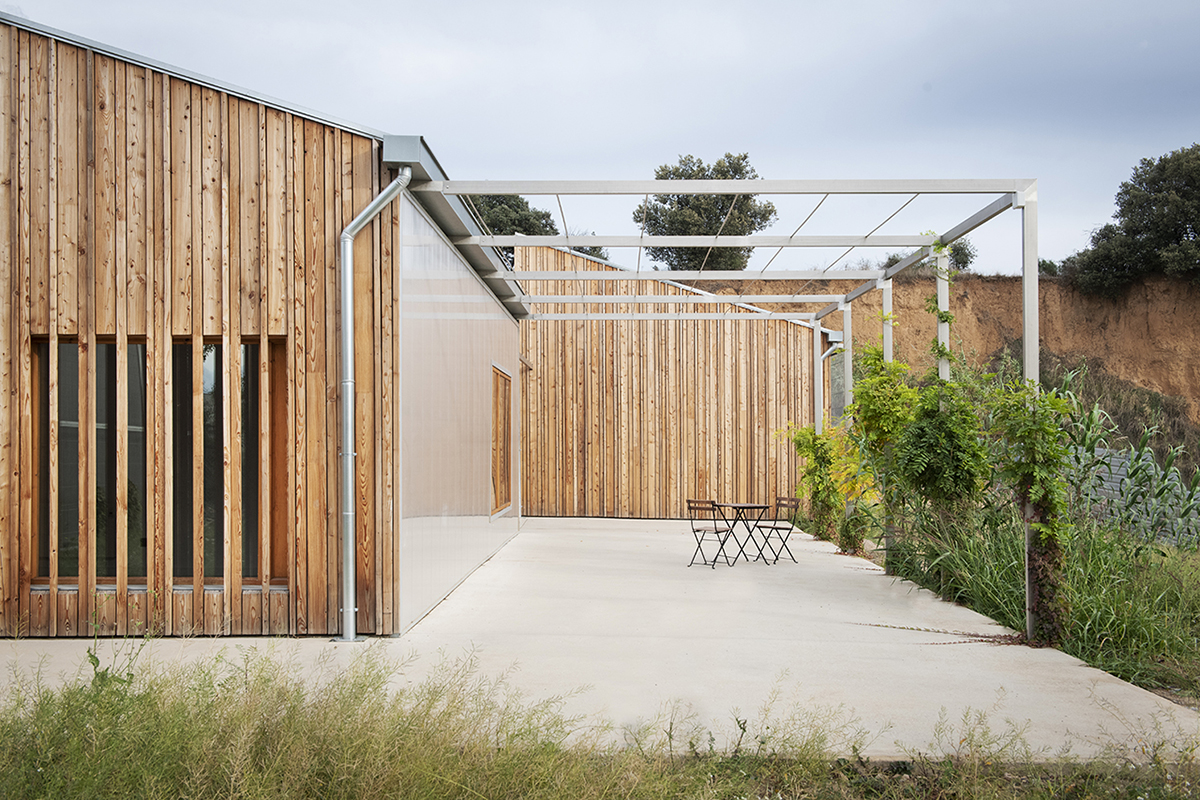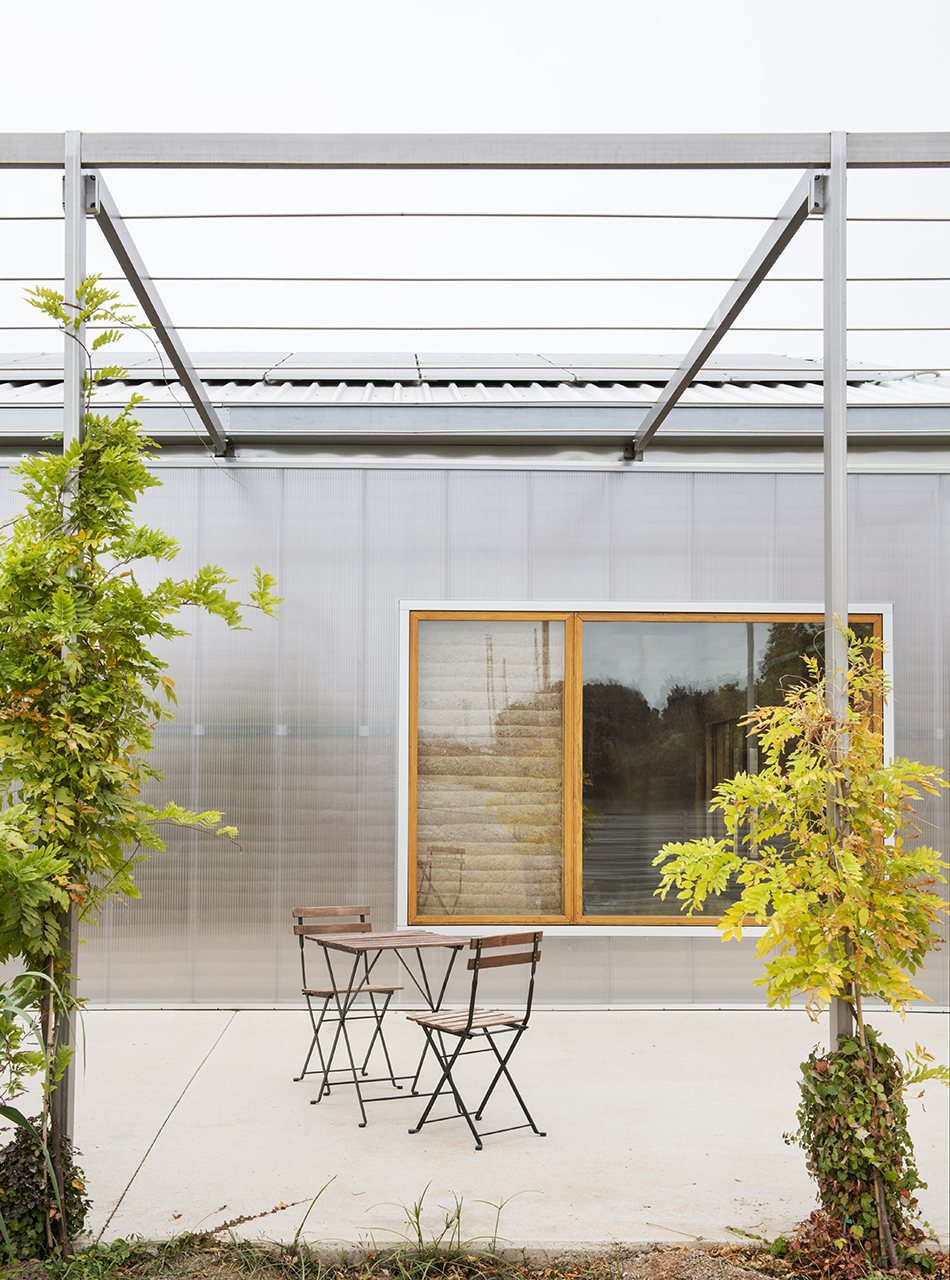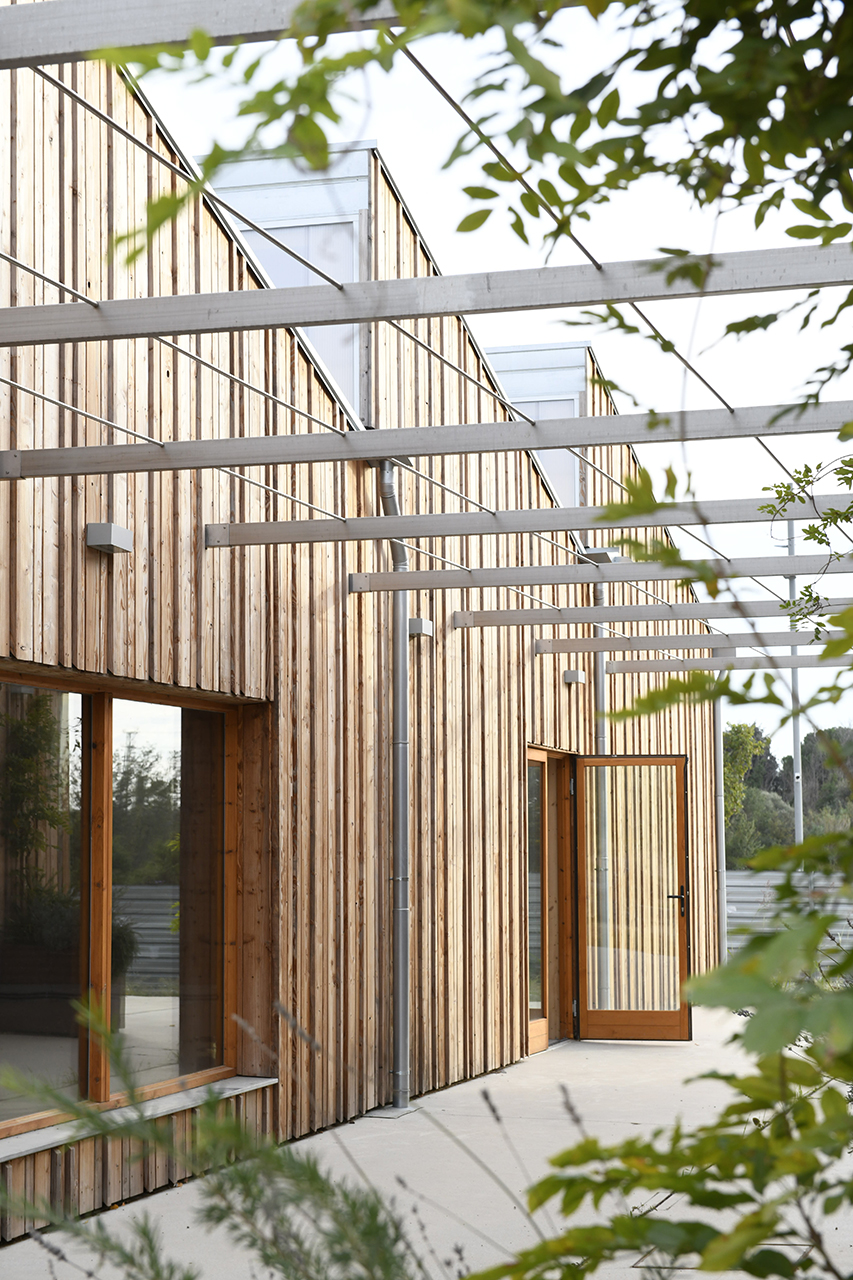The central volume of administration and cafeteria concentrates the intensive part of the facilities (bathrooms, kitchens and centralized climate control). The west volume houses the nature classroom linked to the central part, and in the east volume the large room for the interpretation center.
Access to the cafeteria and the room of the interpretation center is made from a large passage shaded with deciduous climbers that also connects the parking area to the south with the Falgar park.

Franqueses del Vallés Nature Classroom by Edra Arquitectura Km0 and Bunyesc arquitectes. Photograph by Stella Rotger.
It is heated with passive systems and very low energy demand. The inertial walls on the south façade, the super-insulation of the façades and roof and the renovation system using a Canadian well, are innovative climate systems that allow natural materials to be activated, making them participate actively in the comfort of the user.
The bioclimatic operation of the new nature classroom will form part of the dissemination of ecological and water management that is carried out in the meander. The building aims to be a model of public building with low environmental impact, and a powerful circular economy exercise has been carried out in its construction.

Franqueses del Vallés Nature Classroom by Edra Arquitectura Km0 and Bunyesc arquitectes. Photograph by Stella Rotger.
Project description by Edra Arquitectura Km0 and Bunyesc arquitectes
The building of the Nature Classroom of Franqueses del Vallés is promoted by the City Council in the meander of the Gongost river in the Falgar park in order to house some classrooms and training spaces with an administration and cafeteria part.
The project is resolved in three permeable containers in which the different uses are distributed (reversibly) so that future changes of use and subdivisions are possible, deliberately allowing the evolution, reform or reuse of the public building.
The central volume of administration and cafeteria concentrates the intensive part of facilities (bathrooms, kitchens and centralization of climate control) and in the west volume is located the nature classroom linked to the central part. In the eastern volume, the large room used as an interpretation center has access from the outside and to the north some bathrooms serve the Falgar park.
Access to the cafeteria and the room of the interpretation center is made from a large passage shaded with deciduous climbers that also connects the parking area to the south with the Falgar park. The aggregation of volumes is integrated into the structure of the park, the tree vegetation on the river bank and the vegetation and geological cuts of the terrain at the limit of the meander. The building takes into account local resources (material, energy and social).

Franqueses del Vallés Nature Classroom by Edra Arquitectura Km0 and Bunyesc arquitectes. Photograph by Stella Rotger.
The building is built based on natural and local materials. The walls to the south are built on land, the land comes from landslides from the meander itself. The "Tapia" technique is used, which is a practically disappeared local construction technique that is recovered with the deliberate intention of reseeding the technique. This construction technique drastically reduces the environmental impact of the building since the material is extracted directly from nature, it does not require energy for its processing, it does not contain additives and at the end of the useful life of the building it is reintegrated directly into nature without generating any impact. . The east, west and north façades of the building roof are resolved in a prefabricated wooden framework. The isolation is carried out by injection of cellulose. The dry-built sheet metal cover is reusable. As well as the polycarbonate and glass enclosure that forms the outer layer of the earth inertia walls of the south façade.
The prefabrication of the wooden frames and the skin of the wooden façade is carried out in a workshop and the assembly is carried out with a crane. This industrialization made by hand, but in a deferred place, allows a valuation of the work of carpenters and material efficiency and execution time. The wall also executed by hand, but improving the execution processes through the mechanization of mixing, lifting and tamping, results in the appreciation of the artisan execution of architecture. The contract makes a conscious selection of local artisans who can through a simple technical training carried out by the Facultative direction when integrating the processes to replicate them in the future, what we call a planting of low environmental impact technologies.

Franqueses del Vallés Nature Classroom by Edra Arquitectura Km0 and Bunyesc arquitectes. Photograph by Stella Rotger.
The building is passively air-conditioned and ventilated. In winter, the inertia walls built on the ground on the south façade capture and accumulate the energy of the sun and, with a thermal delay, transfer it passively into the interior of the spaces. The strategy of super insulation of the rest of the façades and roof encapsulates the heat inside. In summer, the vegetable skins of the southern façades and the hygrothermally pergolas recede the outside climate, significantly reducing the temperature and shading the inertial walls. The interior spaces are super insulated in all orientations and in the south the earthen wall steals temperature from the interior space, producing a cooling effect.
A Canadian well system, with the collector buried in the park on the north façade, captures the air, tempers it and discharges it through gratings on the floor of the spaces. This system is activated by temperature and CO2 sensors that allow a detailed control of the renovation to avoid thermal losses in winter and that allows ventilation (freecooling) in summer. The fans from the Canadian well are coordinated, and drive extraction grilles placed in the upper part of the skylights.
On the roof, photovoltaic panels capable of producing all the energy required by the building are installed, producing even a surplus in various periods of the year, making the building a positive building. A life cycle analysis is carried out, which yields an impact figure of 265 kg CO2 eq./m2. This low environmental impact is achieved through the conscious selection of low-impact materials in all parts of the building and by minimizing climate systems.


































